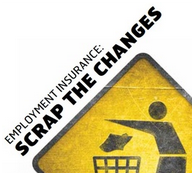 Employment Insurance is just that – insurance that you pay for, every paycheck. When you lose your job through no fault of your own, you should have access to the benefits you paid for. Yet, fewer than 4 in 10 unemployed Canadians qualify for EI benefits. Stephen Harper’s changes to EI are hurting Canadians just when they need Employment Insurance the most.
Employment Insurance is just that – insurance that you pay for, every paycheck. When you lose your job through no fault of your own, you should have access to the benefits you paid for. Yet, fewer than 4 in 10 unemployed Canadians qualify for EI benefits. Stephen Harper’s changes to EI are hurting Canadians just when they need Employment Insurance the most.
Among the devastating changes introduced by the Harper Conservative government through the 2012 budget, out-of-work Canadians must now accept any job the government deems “suitable”—even if it takes you off your career path and comes with a 30 per cent pay cut and hour-long commute—or EI benefits will be cut off entirely. The tribunal system for appeals to denied EI claims was also eliminated.
Help us show the real impact of these new rules. If you are having trouble with EI, please send your stories to eiwatch@cupe.ca. You can send your whole story, or just let us know how to contact you.
- Learn more: Watch the video – Stephen Harper’s changes to EI
Recent articles on Employment Insurance:
Effective January 1, 2017, the waiting period to collect Employment Insurance (EI) was reduced from two to one weeks. The reduced waiting period will apply to all forms of EI benefits including regular, special (maternity, parental and sickness), and benefits for the fishing industry. This change may affect CUPE members whose collective agreements provide supplemental unemployment benefit (SUB) plans and top-ups to maternity, parental, sick leave and short-term disability. Employer payments (i.e. vacation pay) are normally clawed back from EI payments, however SUB and top-up plans are treated differently. Members covered by SUB plans may earn a maximum of 95% of normal weekly earnings. In the case of maternity and other top-up plans, the amount is 100%.
To avoid unintended claw backs to negotiated SUBS and top-ups, the federal government has agreed to a four year “transition period” that will end on January 3, 2021. The transition period will provide the union and the company an opportunity to amend negotiated SUBs and top-ups and avoid claw backs by EI when income exceeds the allowable limits.
The well-being of Canadians, especially during difficult economic times, is dependent on a robust social safety net. What is now called Employment Insurance (EI) is a key part of this because it kicks in when workers and communities need it most. Employment Insurance helps workers make ends meet and softens the blow for communities hard hit by layoffs—or at least it should!
Canada’s EI program turns 75 years old October 2015. As can be seen by the following timeline, what was once a central pillar holding up our social safety net has been eroded by successive cuts.
